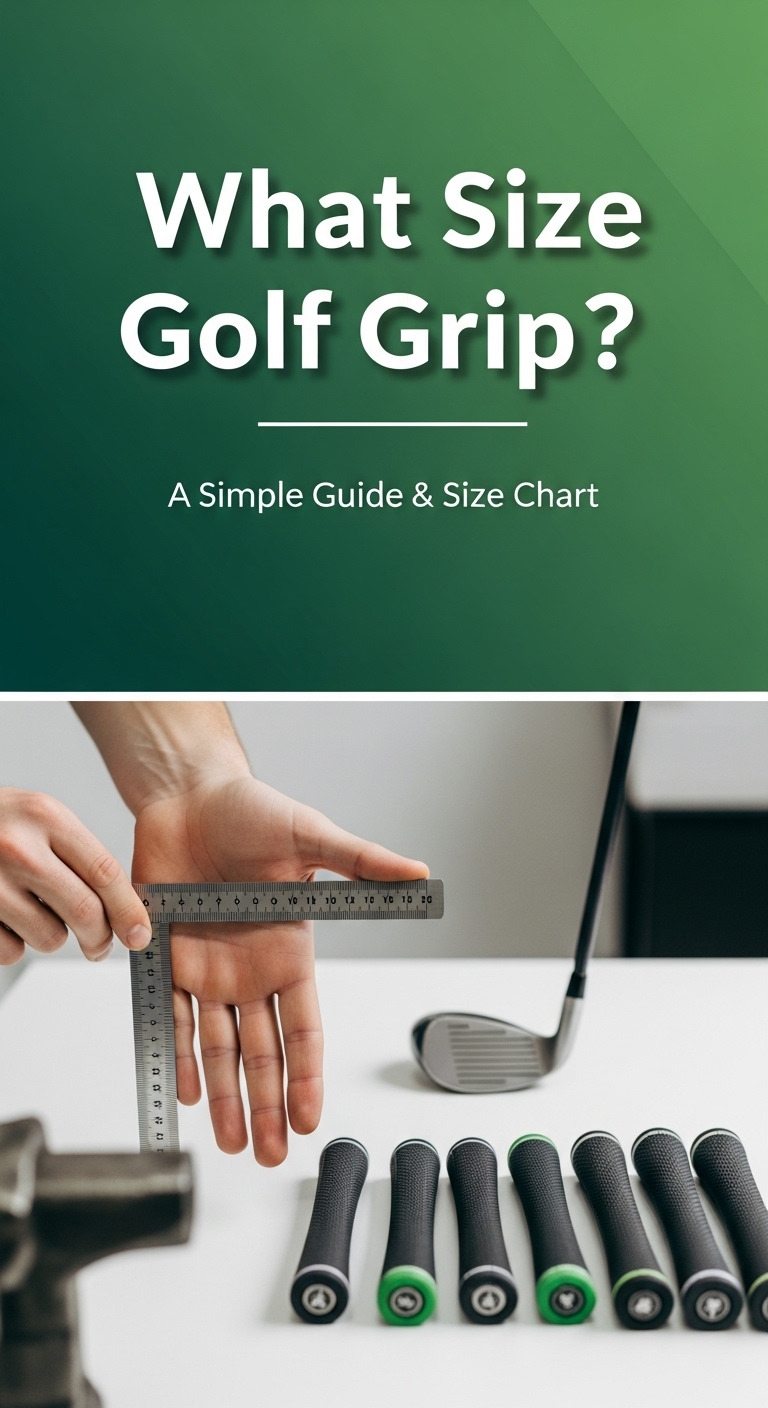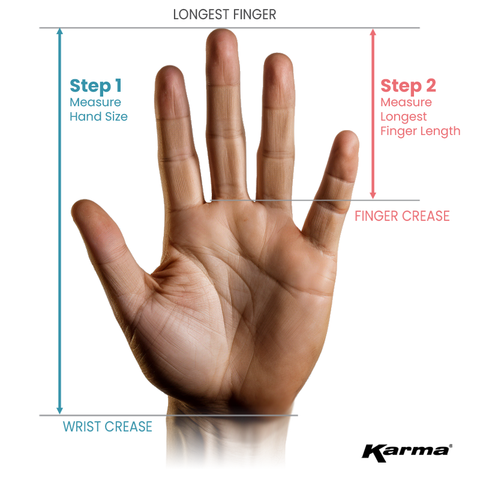As an Amazon Associate GolferHive.com earns from qualifying purchases.
What Size Golf Grip? A Simple Guide & Size Chart
Did you know that the small detail of your grip size could be costing you strokes every single round? Many golfers struggle with inconsistent shots, nagging hooks, or frustrating slices, never realizing the root cause might be right in their hands. An ill-fitting grip forces you to make subtle, unconscious compensations in your swing, sabotaging your game before it even starts.
The correct golf grip size is your only connection to the club, directly impacting club control, shot consistency, and ball flight. An incorrect size can lead to hooks, slices, and lost strokes.
Leveraging extensive analysis of club-fitting data and established performance patterns, this guide provides a definitive answer to the question, “what size golf grip do I need?” We will unpack the proven, step-by-step methods to find your perfect fit, moving from simple at-home checks to precise measurements. Get ready to stop guessing and start playing with confidence.
Key Facts
- The Finger Test: A proper golf grip size is achieved when the tips of your longest fingers in your lead hand barely touch the heel pad of your hand when gripping the club.
- The Measurement Standard: According to detailed sizing charts, a hand measuring between 7 inches and 8.75 inches from wrist crease to longest fingertip typically requires a standard size grip.
- The Slice Corrector: If you consistently slice the ball, a grip that is too large may be inhibiting your ability to square the clubface at impact; a smaller grip can encourage proper hand action.
- The Hook Antidote: A grip that is too small can cause overactive hands, leading to a quick release and a hook. A larger grip can help quiet the hands and straighten out ball flight.
- The Tape Trick: You can fine-tune your grip size with tape. As a rule of thumb highlighted by club-fitters, three extra wraps of standard grip tape can effectively build a standard grip up to a midsize diameter.
Step 1: Understand Why the Correct Golf Grip Size is Crucial
The correct golf grip size is one of the most fundamental yet frequently overlooked aspects of equipment fitting. It is, quite literally, your only connection to the golf club. Every ounce of power, feel, and control is transferred from your body through your hands to the clubhead via this single point of contact. An ill-fitting grip can silently undermine your entire swing, forcing your hands and muscles into unnatural positions. This foundational knowledge is something that even many experienced golfers overlook, playing for years with incorrectly sized grips that are actively working against their game.

When you have the wrong what size golf grip, your game can suffer in numerous ways:
* Compensatory Movements: Your hands and wrists will adjust unnaturally to secure the club, leading to inconsistencies in your swing path and clubface angle.
* Poor Shot Consistency: Without a secure and comfortable hold, it’s nearly impossible to repeat the same swing motion, resulting in poor shot dispersion and unpredictable results.
* Unwanted Ball Flight: A grip that is too small often leads to overactive hands and a hook, while a grip that is too large can restrict hand rotation and cause a slice.
* Bad Turf Interaction: Incorrect hand action originating from a poor grip can lead to hitting shots fat or thin.
Ultimately, determining the right what size golf grip isn’t just about comfort; it’s about giving yourself the best possible chance to execute a clean, powerful, and consistent golf shot.
Step 2: Perform an Initial Grip Size Assessment at Home
Before you break out the rulers and charts, you can get a very good initial idea of your grip size with two simple tests using the clubs you already own. These methods provide a quick and easy starting point for anyone wondering what size golf grip they might need.
Pro Tip: Grab your lead hand glove and your 7-iron right now and use these two quick tests. The results might surprise you.
The Glove Size Correlation Method
While it’s not the most precise method, there’s a strong correlation between the size of your golf glove and the grip size you’ll likely feel most comfortable with. This method serves as an excellent general starting point. As an E-E-A-T cue, it’s important to remember this is a general guideline; the measurement tests that follow will provide a more precise fitting.
| Glove Size | Likely Grip Size |
|---|---|
| Small / Women’s Medium | Undersize |
| Men’s Medium / Medium-Large | Standard |
| Men’s Large | Midsize (or Standard + wraps) |
| Men’s Extra-Large | Midsize or Jumbo |
A men’s medium or medium-large glove typically suggests a standard grip, while an extra-large glove points towards a midsize or jumbo grip. This simple check can instantly tell you if you’re in the right ballpark.
The Lead Hand Finger Test
This physical check is one of the most reliable and time-tested methods for assessing your current grip fit. It tells you exactly how your hands interact with your current grip diameter.
- Hold the club naturally in your lead hand (your left hand if you’re a right-handed golfer).
- Gently wrap your fingers around the grip as if you were preparing to hit a shot.
- Observe where the fingertips of your two longest fingers (the middle and ring finger) make contact with the heel pad of your hand.
The results are easy to interpret:
* Correct Fit: In a correct fit, your longest fingers should barely touch the heel pad of your hand. This creates a secure connection without any tension.
* Grip is Too Small: If your fingertips dig firmly into your palm, the grip is too small. This can cause your hands to become too active in the swing, often leading to a hook.
* Grip is Too Large: If there is a noticeable gap between your fingertips and your palm, the grip is too big. This restricts your ability to release the club properly, which can make it difficult to square the clubface and often leads to a slice.
Step 3: Get a Precise Fit with Hand Measurements & a Size Chart
While the initial tests are great for a quick assessment, the most accurate self-fitting method involves precise measurements. This data-driven approach removes the guesswork and is the same fundamental method used by professional club-fitters. Time to get precise. Grab a ruler or tape measure and let’s find your exact number.
Here’s how to measure your hand to determine what size golf grip you need:
1. Identify your lead hand (the top hand on the club). For a right-handed player, this is your left hand.
2. Open your hand flat with your fingers extended together.
3. Measure from the dominant crease at the base of your wrist to the very tip of your longest finger.

Once you have your measurement, you can compare it to a standard golf grip size chart. While exact numbers can vary slightly between manufacturers like Golf Pride, these industry-standard guidelines are highly reliable.
| Hand Length (Wrist to Fingertip) | Recommended Grip Size |
|---|---|
| Less than 7 inches | Undersize / Junior |
| 7 inches to 8.75 inches | Standard |
| 8.25 inches to 9.25 inches | Midsize |
| Longer than 9.25 inches | Oversize / Jumbo |
For a precise fit, measure from the crease of your wrist to the tip of your longest finger. A hand measuring 7 to 8.75 inches typically requires a standard grip, while one over 9.25 inches needs a jumbo grip. This measurement is the most critical piece of data for selecting the right base grip size.

Step 4: Fine-Tune Your Grip with Tape for a Custom Feel
What if your measurements fall between two sizes, or you simply want a slightly different feel than what’s offered off the shelf? This is where grip tape becomes an invaluable tool for customization. This is an advanced technique used by discerning players and club-fitters to achieve a perfect, personalized feel.
Adding layers of build-up tape underneath the grip allows you to make micro-adjustments to the overall diameter.
* Each layer of standard double-sided grip tape adds approximately 0.015 inches to the thickness of the grip.
* Adding 2 to 4 wraps of tape can create that perfect “in-between” size for golfers who find a standard grip too thin and a midsize grip too thick.
* You can also apply tape to specific sections. For instance, some players add extra wraps to the lower half of the grip to build it up, which can help quiet the bottom hand for more control and accuracy.
As a common rule of thumb among club builders, adding three full layers of tape underneath a standard-sized grip will build it up to feel almost identical to a midsize grip.
Pro Tip: If you’re experimenting with tape, only change one or two clubs (like a wedge and a mid-iron) to test the feel before committing to the whole set. This allows you to compare the feel on the course and range without making a drastic change to all your clubs at once.
Step 5: Consider Your Swing and Physical Needs
Moving from pure measurement to a holistic, player-centric fitting approach is the final piece of the puzzle. Beyond the numbers, your unique swing characteristics and physical comfort should influence your final decision on what size golf grip is best for you.
Could your grip be fighting your natural swing instead of helping it? Let’s see how a size change can help correct your ball flight.
Ball Flight Correction
Your grip size can be used strategically to help correct common swing faults.
* Fighting a Hook: If you consistently hook the ball, your hands may be too active, causing the clubface to close too quickly. A larger grip (midsize or jumbo) can help reduce that excessive hand and wrist rotation, promoting a straighter shot.
* Fixing a Slice: If you slice the ball, your hands might not be releasing the club fast enough to square the face at impact. A smaller grip (undersize or standard) can encourage more natural hand action and make it easier to turn the club over.
Comfort for Arthritis or Hand Pain
For golfers who experience arthritis, hand pain, or a weaker grip strength, comfort is paramount.
* Thicker, Softer Grips: Many brands offer grips specifically designed for these needs. These are often thicker and made from softer, more shock-absorbent materials.
* Reduced Grip Pressure: A larger, softer grip allows you to hold the club securely with less pressure, which can significantly alleviate pain and fatigue in your hands, wrists, and forearms during a round.
Step 6: When to Seek a Professional Club-Fitter
While the steps in this guide will get you extremely close to your ideal fit, there is no substitute for professional expertise. For the most precise fit tailored to your unique swing, a consultation with a certified club-fitter is the highly recommended final step, especially for serious golfers looking to optimize every aspect of their equipment.
A professional offers benefits you can’t get on your own. They perform dynamic fittings, where they watch you hit balls and analyze not just your hand size, but how your hands and wrists move during your actual swing. They can identify subtle nuances in your release pattern and pressure points, allowing them to recommend the absolute perfect combination of grip size, texture, and taper for your game. This expert advice is the gold standard for achieving a truly optimized grip fit.
Understanding an Often-Overlooked Detail: Grip Core Size
When you’re shopping for grips, you may see numbers like “.580” or “.600” listed in the product details. This refers to the grip’s core size, which is a technical detail that can sometimes cause confusion. Understanding this concept demonstrates a deeper technical knowledge and helps you make the most informed choice.
The grip’s core size is its inner diameter, designed to match the outer diameter of the golf shaft’s butt end.
* The most common grip core sizes are .600 inches (often labeled “60”) and .580 inches (often labeled “58”).
* Most modern steel and graphite shafts have a butt diameter of .600 inches.
For example, a 58 core grip is designed to fit over a 0.580″ shaft and create its stated size, while a 60 core grip is designed to fit over a 0.600″ shaft. Yes, it is possible to interchange these different core size golf club grips.
Putting a .600 core grip on a .600 shaft will result in the grip’s stated size (e.g., a “Standard .600″ grip on a .600 shaft will feel like a standard grip). However, if you install a .580 core grip on that same .600 shaft, the grip will be stretched slightly, making the final installed size a little thicker, or about +1/64”. This is another advanced technique fitters use to create “in-between” sizes.
To get started on your own, equipping yourself with quality grip tape and a new set of properly sized grips can make all the difference.
FAQs About what size golf grip
What is the difference between standard and midsize golf grips?
The primary difference is the diameter. A midsize grip is 1/16 of an inch larger in diameter than a standard grip. While this sounds small, it’s a very noticeable difference in feel. Midsize grips are designed for golfers with larger hands or for those who want to reduce hand action in their swing.
Do most pro golfers use standard or midsize grips?
The vast majority of PGA Tour pros use a standard size grip. However, a significant number of them customize this standard grip by adding multiple layers of tape underneath to achieve a unique size that fits their hands perfectly. A smaller but notable group of pros, like Bubba Watson, do use midsize or even jumbo grips.
How do I know for sure if my golf grip is too small?
The most reliable indicator is the lead hand finger test. If you grip the club and your longest fingertips are digging uncomfortably into the heel pad of your hand, your grip is almost certainly too small. This can lead to excessive hand rotation and a tendency to hook the ball.
What happens if your golf grip is too big?
If your grip is too big, you will likely see a significant gap between your fingertips and your palm when you hold the club. This makes it difficult to securely hold and control the club, and more importantly, it can restrict the natural wrist action needed to square the clubface at impact, often resulting in a block or a slice.
Can I put a .580 core size grip on a .600 shaft?
Yes, you absolutely can. Installing a .580 core size grip onto a more common .600 butt diameter shaft will cause the grip to stretch slightly. This will make the final installed grip feel slightly larger than standard, effectively making it a “standard plus” size, which is a great option for someone who finds standard too small but midsize too large.
How many wraps of tape equals a midsize grip?
The general rule of thumb used by club-fitters is that three complete wraps of standard two-sided grip tape will increase the diameter of a standard grip by approximately 1/16th of an inch, making it feel and play like a midsize grip. This is a popular and effective way to customize grip size.
What size grip is best for a beginner golfer?
The best size for a beginner is not a generic “beginner size.” The best approach is to follow the measurement method outlined in this guide. Measure your hand from wrist to fingertip and consult a sizing chart. Starting with a grip that is properly fitted to your hand from day one will help you develop better swing habits.
Do I need the same size grip on all my clubs, including my irons and driver?
Most golfers benefit from having the same size grip on all their clubs (excluding the putter) to ensure a consistent feel throughout the set. However, this is ultimately a matter of personal preference. Some players experiment with a larger grip on their driver to promote more control, while others might prefer a different feel on their wedges.
Final Summary: Finding Your Perfect Golf Grip Size
Determining the correct what size golf grip is a game-changing adjustment that can have an immediate and profound impact on your control, comfort, and consistency. By moving beyond guesswork and using the data-driven methods in this guide, you can equip yourself with grips that are perfectly tailored to your hands and your swing, not the other way around.
Now that you have the tools and knowledge, you’re ready to stop guessing and start playing with grips that are truly fit for your hands. Take these steps and feel the difference in your game.
* Check Your Fit: Start with the simple Glove Size Correlation and Lead Hand Finger Test to get an immediate baseline on your current clubs.
* Measure for Precision: For the most accurate sizing, measure your hand from the wrist crease to the tip of your longest finger and compare it to a standard sizing chart.
* Fine-Tune and Experiment: Don’t be afraid to use grip tape for micro-adjustments or to test different sizes on a few clubs to find what helps your ball flight and feels best.
Last update on 2025-09-15 / Affiliate links / Images from Amazon Product Advertising API

